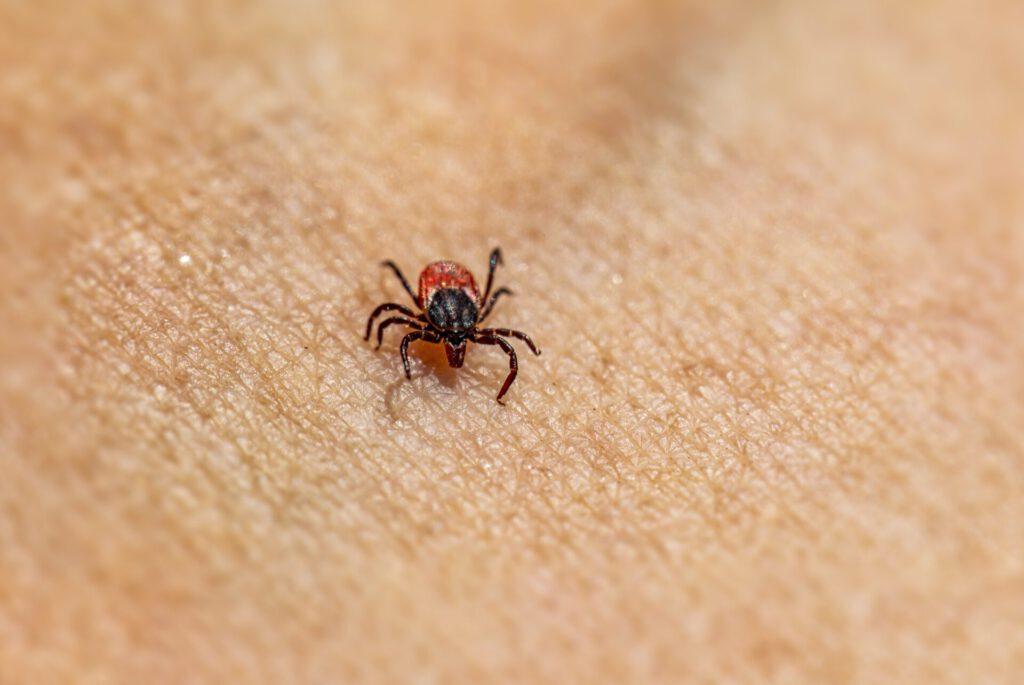Lyme Disease – Long-term Consequences Due to Persistent Bacterial Debris

Long-term consequences due to persistent bacterial debris
Some people develop late sequelae such as Lyme arthritis after Lyme borreliosis. Researchers from the USA have now identified persistent, pro-inflammatory proteins of the pathogen Borrelia burgdorferi as possible triggers of the late sequelae.
Ticks can transmit not only the TBE virus, which causes tick-borne encephalitis, but also Borrelia, especially Borrelia burgdorferi in our latitudes. The bacteria trigger Lyme disease. They are located in the gut of the fasting tick and migrate into the salivary glands during the sucking process, from where they are transmitted to humans. Therefore, the tick must remain on the host for several hours, usually at least 24 hours, so that it can transmit Borrelia.
According to the Robert Koch Institute, approximately 6 to 35 percent of ticks in Germany are infested with Borrelia. After a tick bite, a disease can occur that affects several body systems, including skin, nervous system, joints and heart.
In Europe, the incidence of reported cases of Lyme disease is approximately 30,000 per year. However, it is suspected that there are more likely 150,000 cases per year. While the acute infection responds well to antibiotic treatment with doxycycline, post-infectious complications of Lyme disease are particularly problematic. These include in particular post-infectious Lyme arthritis syndrome (PLAS) and Posttreatment Lyme Disease Syndrome (PTLDS). This is a chronic clinical picture that occurs months to years after an infection and is characterized by fatigue,
In an article published in the journal »Science Translational Medicine«, Dr. Mecaila McClune and colleagues from the Feinberg School of Medicine at Northwestern University in Chicago report that peptidoglycan fragments of the bacterial cell wall may be responsible as persistent antigens for the late sequelae of Lyme disease.
Using a mouse model, the researchers demonstrated that polymeric peptidoglycan fragments accumulate in the liver and spleen of the animals after systemic application and persist there for weeks. This persistence is chemically conditioned, because the peptidoglycan fragments of Borrelia burgdorferi (PGBb) have special structural elements such as L-ornithine in the stem peptide and the unusual glycan end motif G-G-anhM. This component in particular appears to promote the prolonged residence time. Because comparative studies with peptidoglycan cell walls of other bacteria, including Escherichia coli, Staphylococcus aureus or Deinococcus radiodurans, showed a significantly faster clearance, which indicates the uniqueness of PGBb with regard to its persistence.
Cellular uptake and storage
In vitro studies have shown that both Kupffer cells, known as liver macrophages, and hepatocytes phagocytose PGBb. While Kupffer cells take up different peptidoglycan types, hepatocytes preferentially phagocytosed PGBb. In contrast, intact B. burgdorferi cells are hardly phagocytosed by hepatocytes.
Although the accumulation of PGBb in the liver showed only minor tissue damage, permanently elevated liver values (ALT, AST) were measured, which indicates an unnoticed liver dysfunction. Examinations of the liver tissue also showed a significant accumulation of immune proteins, especially those involved in Toll-like receptor signaling pathways (TLR1/2), the activation of neutrophils and defense reactions against viruses – similar to the patterns observed in Long Covid.
When human peripheral mononuclear blood cells (PBMC) were stimulated with PGBb, this led to a stronger gene expression than stimulation with other peptidoglycans. For example, the energy metabolism gene regulation changed after the stimulation and the genes of CCL19 and IL-23, which are typically associated with PTLDS, were more active.
Human relevance: Detection in patient samples
With a newly developed monoclonal antibody (r-mAb2G10), the researchers were able to detect polymeric PGBb (pPGBb) in the synovial fluid of humans for the first time. In 90 percent of the samples from patients with PLAS, pPGBb could also be detected immunologically after antibiotic treatment, whereas control samples from other forms of arthritis remained negative. This suggests that polymeric, not completely degraded PGBb is a relevant pathophysiological factor in the chronic phase of Lyme disease.
According to the authors, pPGBb as a persistent pathogen-associated molecular pattern (PAMP) could play a key role in the chronification of symptoms after B. burgdorferi infection by continuously being released from the liver, permanently activating immune reactions, disrupting metabolism pathways and possibly triggering autoimmune processes.
This hypothesis is supported by parallels to other post-infectious syndromes such as Long Covid. How the cell wall residues trigger inflammation and cause symptoms still needs to be investigated in more detail in order to develop diagnostic markers and targeted therapies for the disease, in particular to avoid unnecessary antibiotic therapies or immunosuppressant administrations.
Source:
https://www.pharmazeutische-zeitung.de/langzeitfolgen-durch-langlebige-bakterienreste-155515/
https://www.science.org/doi/10.1126/scitranslmed.adr2955
